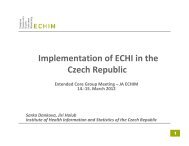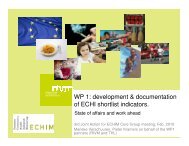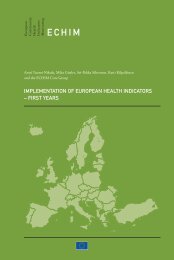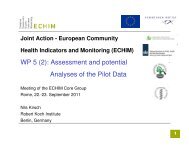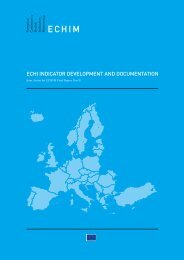INDICATORS
ECHIM Final Report
ECHIM Final Report
You also want an ePaper? Increase the reach of your titles
YUMPU automatically turns print PDFs into web optimized ePapers that Google loves.
Calculation: Life expectancies are calculated using (abridged) life tables presenting age<br />
specific mortality rates.<br />
1) Eurostat: Life expectancy tables are calculated based on death probabilities according to<br />
Farr’s death rate method: qx = Mx / (Bx + (Mx/2)) where Mx = the number of deaths at the<br />
age of x to under x+1 years in the reported period; Bx = average population aged x to under<br />
x+1 in the base period; qx = death probability from age x to x+1.<br />
2) WHO: Calculated for all countries which report detailed mortality data to WHO, using<br />
Wiesler’s method. Age disaggregation of mortality data: 0, 1–4, 5–9, 10–14, etc, 80–84, 85+.<br />
Presentation by ages 1, 15, 45, 65, by gender and total population.<br />
3) OECD: Calculated at birth and at various ages (40, 60, 65, 80).<br />
ECHIM prefers 1.<br />
Notes: Different calculation methods of abridged life-tables produce slightly different results.<br />
Farr’s method of calculation of abridged life-tables assumes that there is a constant mortality<br />
within the age intervals and thus the years of life lived by a person dying in the interval is<br />
(on average) half of the length of the interval. Wiesler’s method does not assume constant<br />
mortality through the age interval, but rather function of survival. The method uses specified<br />
values for time by age groups. These values for the calculation of average “survival” during<br />
the period were originally derived from comparisons of many countries with complete data<br />
(in the early 1950s). Wiesler’s method is a simple method that can be used with incomplete<br />
and/or aggregated data. It is not as precise regarding the calculation of survival as most other<br />
methods. However, the difference in life expectancy calculated by these two methods is<br />
neglectable.<br />
11. INFANT MORTALITY<br />
Definition: Infant Mortality Rate is defined as the number of deaths of infants (younger<br />
than one year of age at death) per 1000 live births (based on one year data).<br />
Calculation:<br />
1) Eurostat: Number of deaths under one year of age (day 0–364) in a given year, per 1000<br />
live births in that year.<br />
2) Peristat: Number of infant deaths (day 0 through 364) after live birth at or after 22<br />
completed weeks of gestation in a given year , per 1000 live births in the same year.<br />
3) WHO: Number of deaths in a year of children less than 1 year of age per number of live<br />
births in the same year, per 1000.<br />
ECHIM prefers 1.<br />
Notes: For variant 2, records of gestation time are needed. For live births the variation of<br />
registration criteria effects less than for perinatal mortality. However, the registration of the<br />
infants with very short gestation may cause variation between countries.<br />
12. PERINATAL MORTALITY<br />
Definition: Perinatal Mortality Rate is defined as the number of fetal deaths plus early<br />
neonatal deaths after live birth in a given year, per 1000 live and stillbirths.<br />
90




